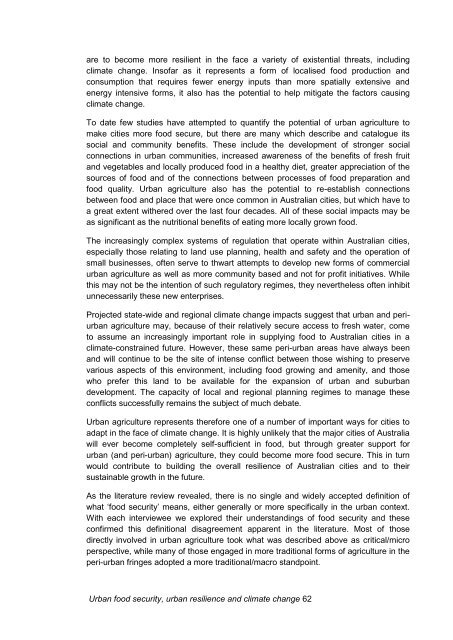Urban food security, urban resilience and climate change - weADAPT
Urban food security, urban resilience and climate change - weADAPT
Urban food security, urban resilience and climate change - weADAPT
Create successful ePaper yourself
Turn your PDF publications into a flip-book with our unique Google optimized e-Paper software.
are to become more resilient in the face a variety of existential threats, including<strong>climate</strong> <strong>change</strong>. Insofar as it represents a form of localised <strong>food</strong> production <strong>and</strong>consumption that requires fewer energy inputs than more spatially extensive <strong>and</strong>energy intensive forms, it also has the potential to help mitigate the factors causing<strong>climate</strong> <strong>change</strong>.To date few studies have attempted to quantify the potential of <strong>urban</strong> agriculture tomake cities more <strong>food</strong> secure, but there are many which describe <strong>and</strong> catalogue itssocial <strong>and</strong> community benefits. These include the development of stronger socialconnections in <strong>urban</strong> communities, increased awareness of the benefits of fresh fruit<strong>and</strong> vegetables <strong>and</strong> locally produced <strong>food</strong> in a healthy diet, greater appreciation of thesources of <strong>food</strong> <strong>and</strong> of the connections between processes of <strong>food</strong> preparation <strong>and</strong><strong>food</strong> quality. <strong>Urban</strong> agriculture also has the potential to re-establish connectionsbetween <strong>food</strong> <strong>and</strong> place that were once common in Australian cities, but which have toa great extent withered over the last four decades. All of these social impacts may beas significant as the nutritional benefits of eating more locally grown <strong>food</strong>.The increasingly complex systems of regulation that operate within Australian cities,especially those relating to l<strong>and</strong> use planning, health <strong>and</strong> safety <strong>and</strong> the operation ofsmall businesses, often serve to thwart attempts to develop new forms of commercial<strong>urban</strong> agriculture as well as more community based <strong>and</strong> not for profit initiatives. Whilethis may not be the intention of such regulatory regimes, they nevertheless often inhibitunnecessarily these new enterprises.Projected state-wide <strong>and</strong> regional <strong>climate</strong> <strong>change</strong> impacts suggest that <strong>urban</strong> <strong>and</strong> peri<strong>urban</strong>agriculture may, because of their relatively secure access to fresh water, cometo assume an increasingly important role in supplying <strong>food</strong> to Australian cities in a<strong>climate</strong>-constrained future. However, these same peri-<strong>urban</strong> areas have always been<strong>and</strong> will continue to be the site of intense conflict between those wishing to preservevarious aspects of this environment, including <strong>food</strong> growing <strong>and</strong> amenity, <strong>and</strong> thosewho prefer this l<strong>and</strong> to be available for the expansion of <strong>urban</strong> <strong>and</strong> sub<strong>urban</strong>development. The capacity of local <strong>and</strong> regional planning regimes to manage theseconflicts successfully remains the subject of much debate.<strong>Urban</strong> agriculture represents therefore one of a number of important ways for cities toadapt in the face of <strong>climate</strong> <strong>change</strong>. It is highly unlikely that the major cities of Australiawill ever become completely self-sufficient in <strong>food</strong>, but through greater support for<strong>urban</strong> (<strong>and</strong> peri-<strong>urban</strong>) agriculture, they could become more <strong>food</strong> secure. This in turnwould contribute to building the overall <strong>resilience</strong> of Australian cities <strong>and</strong> to theirsustainable growth in the future.As the literature review revealed, there is no single <strong>and</strong> widely accepted definition ofwhat ‘<strong>food</strong> <strong>security</strong>’ means, either generally or more specifically in the <strong>urban</strong> context.With each interviewee we explored their underst<strong>and</strong>ings of <strong>food</strong> <strong>security</strong> <strong>and</strong> theseconfirmed this definitional disagreement apparent in the literature. Most of thosedirectly involved in <strong>urban</strong> agriculture took what was described above as critical/microperspective, while many of those engaged in more traditional forms of agriculture in theperi-<strong>urban</strong> fringes adopted a more traditional/macro st<strong>and</strong>point.<strong>Urban</strong> <strong>food</strong> <strong>security</strong>, <strong>urban</strong> <strong>resilience</strong> <strong>and</strong> <strong>climate</strong> <strong>change</strong> 62
















